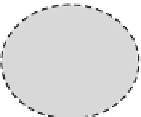Biology Reference
In-Depth Information
Outside
ATP Synthase
Cyt c
2
e
-
Proteorhodopsin
H
+
e
-
Q
Q
QH
2
QH
2
H
+
H
+
H
+
Type II Photosynthetic
Reaction Center
Cytochrome bc
i
complex
AT P
ADP + P
i
CO
2
Fixation
Biosynthesis
Fd
red
NAD(P)H
NADH
Fd:NAD
Type I Photosynthetic
Reaction Center
reductase
Fd
ox
NAD(P)
+
NAD
+
e
-
308
Q
Q
QH
2
QH
2
CymA
H
+
Cyt c
e
-
NADH:quinone
oxidoreductase
MtrA
MtrB
Outside
MtrC
e
-
Electrode
FIGURE 16.2
Integration of light-harvesting components into cell metabolism. Top portion of the figure demonstrates how a proton-
translocating light-capturing system such as proteorhodopsin (PR) or a type II reaction center would integrate with the host
'
s
ATP synthase, providing a boost to cell energy stores. Upon light excitation, PR is able to transfer a proton from the
cytoplasm to the periplasm using the isomerization of a retinol cofactor. Type II RC does not translocate protons directly.
Two protons bind to the reduced quinone on the cytoplasmic side of the membrane and are released on the periplasmic side
during the oxidation of the quinone. The cytochrome bc
1
complex, which couples the oxidation of quinones to the reduction
of cytochrome c2, also translocates protons. The bottom section illustrates how a noncyclic type I RC can be used by the
cell to regenerate reduced equivalents such as NADPH. After light excitation, electrons are transferred onto a ferrodoxin (Fd)
molecule, which can be subsequently oxidized by Fd:NAD reductase in order to regenerate NADH. The transfer of electrons
from the quinone pool through the S. oneidensis MR1 metal reduction (Mtr) pathway to an external acceptor, such as an
electrode, is also shown in the bottom section of the figure.
Over the past several decades, the photosynthetic RCs from different
Rhodobacter
species
have been used as models for the study of light-capturing systems due to their relatively
simple purification and stability after purification, thus making them most amenable for





































































































